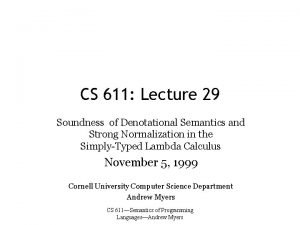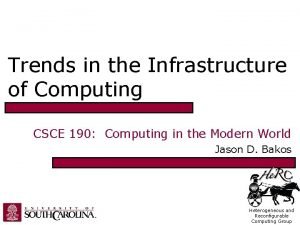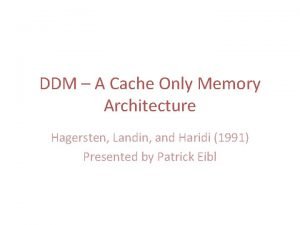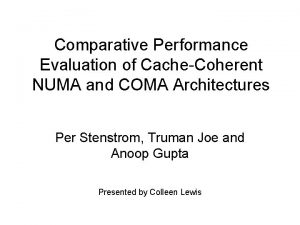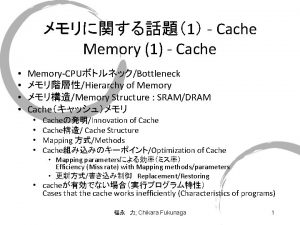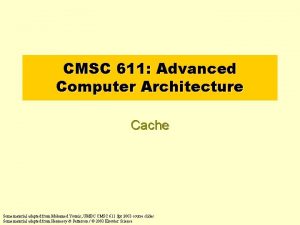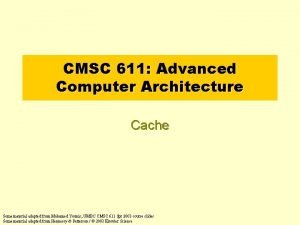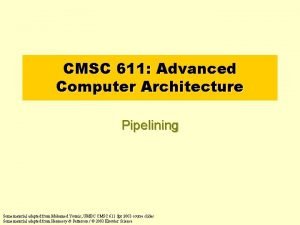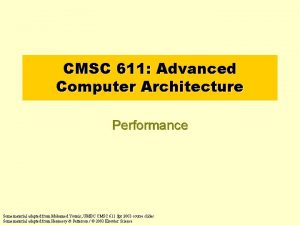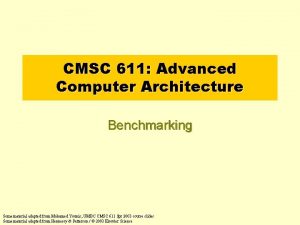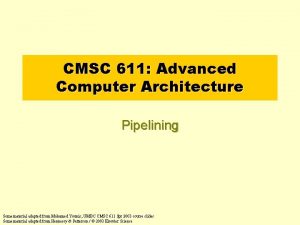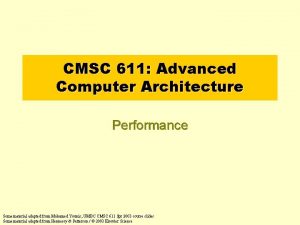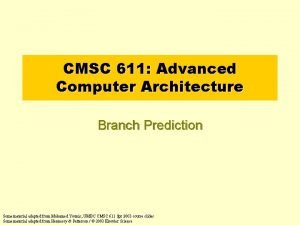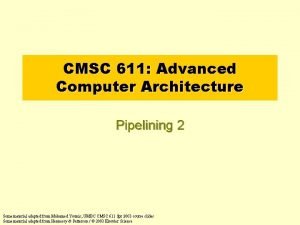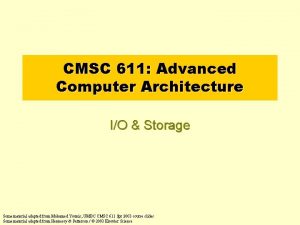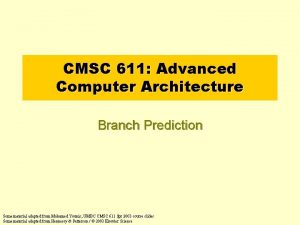CMSC 611 Advanced Computer Architecture Cache Some material












- Slides: 12

CMSC 611: Advanced Computer Architecture Cache Some material adapted from Mohamed Younis, UMBC CMSC 611 Spr 2003 course slides Some material adapted from Hennessy & Patterson / © 2003 Elsevier Science

2 Memory Hierarchy • Temporal Locality (Locality in Time): Keep most recently accessed data items closer to the processor • Spatial Locality (Locality in Space): Move blocks consists of contiguous words to the faster levels Processor Control On-Chip Cache Registers Datapath Second Level Cache (SRAM) Main Memory (DRAM) Secondary Storage (Disk) Compiler Speed: Size: Cost: Fastest Smallest Highest Hardware Operating System Slowest Biggest Lowest

3 The Basics of Cache • Cache: level of hierarchy closest to processor • Caches first appeared in research machines in early 1960 s • In every general-purpose computer produced today Requesting Xn generates a miss and the word Xn will be brought from main memory to cache Issues: • How do we know that a data item is in cache? • If so, How to find it?

Memory Hierarchy Terminology • • • 4 Hit: data appears in some block in the faster level (example: Block X) – Hit Rate: the fraction of memory access found in the faster level – Hit Time: Time to access the faster level which consists of • Memory access time + Time to determine hit/miss Miss: data needs to be retrieve from a block in the slower level (Block Y) – Miss Rate = 1 - (Hit Rate) – Miss Penalty: Time to replace a block in the upper level + Time to deliver the block the processor Hit Time << Miss Penalty To Processor From Processor Faster Level Memory Slower Level Memory Block X Block Y

Memory Hierarchy Design Issues • Block placement – Where can a block be placed in the upper (faster) level? • Block identification – How is a block found if it is in the upper (faster) level? • Block replacement – Which block should be replaced on a miss? • Write strategy – What happens on a write? 5

Block Placement: Direct Mapped • Cache is a table of blocks • Every block in memory maps to one and only one block in cache • Many memory blocks map to the same cache block 6

Block Placement: Set Associative • Cache is a table of N blocks each – Set of N blocks at each index – N-way associative • Every block in memory maps to one and only one index, but can use any of the N blocks at that index • To keep size the same, divide number of indices by N 7

Block Placement: Fully Associative • Any block in memory can use any block in the cache • Like set associative where number of indices = 1 and associativity N = full cache size. 8

9 Block Identification • Partition address • Offset within block Tag Index Offset – 000000 b for first byte in block – 111111 b for last byte in block • Index – Which line in the cache? • Tag – Rest of the address – Store in cache to know you have the right block

10 Block Identification

11 Block Replacment • If all blocks at index are already in use – Must replace one. Which one? • Only one choice for Direct Mapped • Associative: – Least Recently Used (LRU) – Random

12 Write Strategy • Write Back – Write block to lower level when evicted from upper-level cache • Write Through – Update upper-level cache and forward write to lower-level for each write
 64-1278/611 transit check
64-1278/611 transit check 611 biblical meaning
611 biblical meaning Cs 611
Cs 611 Csce 611
Csce 611 Tca 36-3-611
Tca 36-3-611 Fundamentals of cpu in advanced computer architecture
Fundamentals of cpu in advanced computer architecture Cache only memory architecture
Cache only memory architecture Cache only memory architecture
Cache only memory architecture Cache architecture diagram
Cache architecture diagram Oracle cache fusion architecture
Oracle cache fusion architecture Three bus architecture
Three bus architecture Computer organization and architecture difference
Computer organization and architecture difference What is basic computer organization
What is basic computer organization


